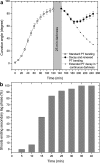Interaction with gravitropism, reversibility and lateral movements of phototropically stimulated potato shoots
- PMID: 27033355
- PMCID: PMC4909813
- DOI: 10.1007/s10265-016-0821-4
Interaction with gravitropism, reversibility and lateral movements of phototropically stimulated potato shoots
Abstract
Phototropic (PT) and gravitropic (GT) bending are the two major tropic movements that determine the spatial position of potato shoots. We studied PT bending of potato plantlets grown under long-day photoperiods in several prearranged position setups providing different interactions with the GT response. Starting with the standard PT stimulation setup composed of unilateral irradiation of vertically positioned shoots, experiments were also done in antagonistic and synergistic setups and in treatments with horizontal displacement of the light source. In the standard setup, PT bending suppressed the GT bending, which could occur only if the PT stimulation was cancelled. The antagonistic position, with phototropism and gravitropism attempting to bend shoots in opposite directions, showed phototropism and gravitropism as independent bending events with the outcome varying throughout the day reflecting diurnal changes in the competence of individual tropic components. Whilst gravitropism was constant, phototropism had a marked daily fluctuation of its magnitude with a prominent morning maximum starting an hour after the dawn in the growth room and lasting for the next 6 h. When phototropism and gravitropism were aligned in a synergistic position, stimulating shoot bending in the same direction, there was little quantitative addition of their individual effects. The long period of morning PT bending maximum enabled multiple PT bending events to be conducted in succession, each one preceded by a separate lag phase. Studies of secondary PT events showed that potato plantlets can follow and adjust their shoot position in response to both vertical and horizontal movements of a light source. PT bending was reversible, since the 180° horizontal change of a blue light (BL) source position resulted in reversal of bending direction after a 20-min-long lag phase.
Keywords: Gravitropism; Phototropism; Reversibility; Solanum tuberosum L.; Tropic interactions.
Figures








Similar articles
-
Gravitropism and phototropism of oat coleoptiles: post-tropic autostraightening and tissue shrinkage during tropism.Adv Space Res. 1999;24(6):743-53. doi: 10.1016/s0273-1177(99)00408-1. Adv Space Res. 1999. PMID: 11542618
-
Tropisms of Avena coleoptiles: sine law for gravitropism, exponential law for photogravitropic equilibrium.Planta. 2002 Sep;215(5):779-84. doi: 10.1007/s00425-002-0813-6. Epub 2002 Jun 13. Planta. 2002. PMID: 12244443
-
Hypocotyl growth orientation in blue light is determined by phytochrome A inhibition of gravitropism and phototropin promotion of phototropism.Plant J. 2004 Dec;40(5):826-34. doi: 10.1111/j.1365-313X.2004.02256.x. Plant J. 2004. PMID: 15546364
-
Toward understanding the ecological functions of tropisms: interactions among and effects of light on tropisms.Curr Opin Plant Biol. 2006 Feb;9(1):89-93. doi: 10.1016/j.pbi.2005.11.012. Epub 2005 Dec 9. Curr Opin Plant Biol. 2006. PMID: 16338162 Review.
-
Shoot phototropism in higher plants: new light through old concepts.Am J Bot. 2013 Jan;100(1):35-46. doi: 10.3732/ajb.1200340. Epub 2012 Oct 9. Am J Bot. 2013. PMID: 23048016 Review.
References
-
- Franssen JM. Phototropism in seedlings of sunflower Helianthus annuus L. Meded Landbouwhogeschool Wageningen. 1980;80:1–83.
MeSH terms
LinkOut - more resources
Full Text Sources
Other Literature Sources
Molecular Biology Databases
Miscellaneous

